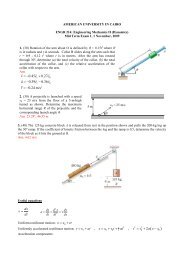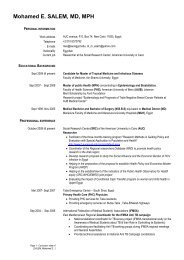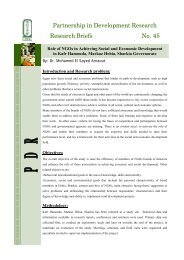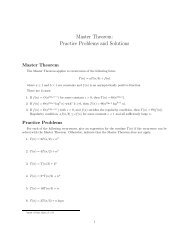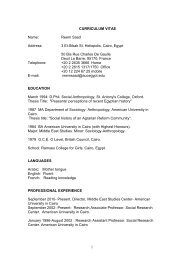J. Nonlinear Mathematical Physics 5 (no.3) (1998)
J. Nonlinear Mathematical Physics 5 (no.3) (1998)
J. Nonlinear Mathematical Physics 5 (no.3) (1998)
Create successful ePaper yourself
Turn your PDF publications into a flip-book with our unique Google optimized e-Paper software.
318 M.B. Abd-el-Malekare the four absolute invariants corresponding to w, r, κ and ρ. The application of a basictheorem in group theory, see [17], states that: a function g(z,t;w,r,κ,ρ) is an absoluteinvariant of a one-parameter group if it satisfies the following first-order linear differentialequationwhere6∑i=1(α i Q i + β i ) ∂g∂Q i= 0; Q i = z,t,w,r,κ,ρ, (2.17)α i = ∂CQ i∂a (a0 ),β i = ∂P Q i∂a (a0 ); i = 1,2,... ,6, (2.18)and a 0 denotes the value of “a” which yields the identity element of the group.Owing to equation (2.17), η(z,t) is an absolute invariant if it satisfies(α 1 z + β 1 )η z + (α 2 t + β 2 )η t = 0, (2.19)Group (2.15) gives:α 1 = β 1 = β 2 = 0, (2.20)and hence from (2.17) and (2.20) we getwhich givesη t = 0, (2.21)η(z,t) = F(z). (2.22)Without loss of generality we can use the identity function:η(z,t) = z. (2.23)By a similar analysis the absolute invariants of the dependent variables w, r, κ and ρ arew(z,t) = Γ(t)F(η),q(z) = B(t)Φ(η),r(z,t) = A(t)Θ(η),g(z) = Y (t)Ψ(η).(2.24)From which we conclude thatq(z) = Φ(η), (2.25)g(z) = Ψ(η). (2.26)At t = 0 : Γ(0) = 0. (2.27)
Application of the Group-Theoretical Method 3192.2.2 The reduction to ordinary differential equationSubstituting from (2.24) into (2.6) and dividing by Γ, we getβΨF ηη + βΨ η F η − αΦΓ m−1 F m+1 Γ t = − A(t)Θ(η) . (2.28)ΓFor (2.28) to be reduced to an expression in the single independent invariant η, it isnecessary that the coefficients should be constants or functions of η alone. ThusΓ m−1 Γ t = C 1 ,Take C 1 = 1:A(t)Γ = C 2. (2.29)Γ(t) = (mt) 1/m , m ≠ 0, (2.30)(2.29) and (2.30) yield:A(t) = C 2 (mt) 1/m , m ≠ 0. (2.31)Hence (2.28) may be rewritten asβΨF ηη + βΨ η F η − αΦF m+1 = −C 2 Θ(η). (2.32)Following Girgis and Smith [18], we assume the heat source distribution in the form:Θ(η) = e −ξη , (2.33)where ξ is the absorption coefficient for water, which has the value 0.048.Take:Φ(η) = Ψ(η) , F(η) ≠ 0, 0 ≤ η ≤ h. (2.34)F(η)According to (2.33) and (2.34), equation (2.32) takes the formWrite:βΨF ηη + βΨ η F η − αΨF m = −C 2 e −ξη . (2.35)Ψ = e −µη , (2.36)where µ is a constant, then (2.35) becomesF ηη − µF η − α β F m = − C 2β e−(ξ−µ)η , (2.37)with the boundary conditions:(i) F(0) = 0, (2.38)(ii) F(h) = γ/m (1/m) . (2.39)
320 M.B. Abd-el-Malek2.2.3 Analytical solution for different forms of the parametersFor m = 1, differential equation (2.37) becomesF ηη − µF η − σ 2 F = − C 2β e−(ξ−µ)η ;and the boundary conditions becomeσ 2 = α β(2.40)(i) F(0) = 0, (2.41)(ii) F(h) = γ, (2.42)which has the exact solutionwhereF(η) = a 1 e r 1η + a 2 e r 2η + a 3 e −(ξ−µ)η , (2.43)r 1,2 = µ ± √ µ 2 + 4σ 2,2r 1 for (+) sign and r 2 for (−) sign, andC 2a 3 = −β(µ − ξ) 2 − µβ(µ − ξ) − α .For finite temperature, a 1 = 0, and applying condition (2.41), we get the solution inthe form:[F(η) = a 3 e −(ξ−µ)η + ξ − µ ]e r 2η. (2.44)r 2Hence the temperature distribution across the lake, corresponding to case (1) is:T(z,t) = T 0 −[C 2 tβ(µ − ξ) 2 − βµ(µ − ξ) − αe −(ξ−µ)z + ξ − µ e r 2zr 2]. (2.45)For 0 < t < 150 (in days), following Girgis and Smith [18], we use the following valuesof the parameters: C 2 = 2496, β = 12355, µ = 1.439239 ×10 −4 , ξ = 0.048, h = 400 meter,T 0 = 4 ◦ C. The obtained results are plotted in Fig.1 and Fig.2.2.3 Case (2): ρ = αq(z)w s , κ = βw nDifferential equation (2.4) takes the formw n w zz + nw n−1 (w z ) 2 − σ 2 q(z)w s w t = −r(z,t). (2.46)Following the same analysis as in case (1), we get the following group G:G : z = z, t = (C w ) m t, q = (C w ) n+m−s q, r = (C w ) n+1 r, w = C w w. (2.47)
Application of the Group-Theoretical Method 321Figure 1. Distribution of temperatureT (time = 40 days) againtsthe lake depth “z” in meters, correspondingto case: ρ = αq(z)w,κ = βg(z) for different values of parameter“α”.Figure 2. Distribution of temperaturefor different times to constant “α”(α = 14095), for ρ = αq(z)w, κ =βg(z).The absolute invariants are:η = z, w(z,t) = Γ(t)F(η), r(z,t) = A(t)Θ(η), q(z) = B(t)Φ(η). (2.48)Again, it is clear that B(t) = 1; from which we getleading toq(z) = Φ(η), (2.49)q = q, (2.50)which is satisfied if and only if (C w ) n+m−s = 1. That is C w = 1 or n = s − m. C w cannot be unity. Hence we obtain the only possible case:Taken = s − m. (2.51)Φ(η) = 1 , F(η) ≠ 0, 0 ≤ η ≤ h, (2.52)F(η)At t = 0 : Γ(0) = 0. (2.53)
322 M.B. Abd-el-MalekFigure 3. Distribution of temperatureT (time = 40 days) againtsthe lake depth “z” in meters, correspondingto case: ρ = αq(z)w,κ = β for different values of parameter“α”.Figure 4. Distribution of temperaturefor different times to constant “α”(α = 13306), for ρ = αq(z)w, κ =βg(z).Following the same analysis as in section (2.2.2), we reach to the following ordinarydifferential equation:F n F ηη + nF n−1 (F η ) 2 − σ 2 F s = −C 2 e −ξη . (2.54)For the case when m = s = 1, and from (2.51), we find n = 0. Hence (2.54) becomesF ηη − σ 2 F = −C 2 e −ξη , (2.55)and the corresponding boundary conditions are:(i) F(0) = 0, (2.56)(ii) F(h) = γ. (2.57)Applying boundary conditions (2.56) and (2.57), we get the solutionF(η) = a 1 e ση + a 2 e −ση + C 2σ 2 − ξ 2e−ξη . (2.58)For finite temperature, a 1 = 0, and applying boundary condition (2.56), we get the solutionin the form:F(η) = C (2σ 2 − ξ 2 e −ξη − ξ )σ e−ση . (2.59)Hence the temperature distribution across the lake, corresponding to case (2) is:T(z,t) = T 0 +C (2tσ 2 − ξ 2 e −ξz − ξ )σ e−σz . (2.60)
Application of the Group-Theoretical Method 323For 0 < t < 150 (in days), following Girgis and Smith [18], we use the following valuesof the parameters: C 2 = 0.2014, β = 12391, ξ = 0.048, h = 400 meter, T 0 = 4 ◦ C, theobtained results are plotted in Fig.3 and Fig.4.3 Application (II): Unsteady free-convective boundary-layerflow on a non-isothermal vertical flat plate3.1 <strong>Mathematical</strong> formulationConsider a natural convective, laminar, boundary layer adjacent to a semi-infinite, verticalflat plate. The fluid is isothermal and of constant temperature T ∞ , far from the plate. Theplate has nonuniform surface temperature T w > T ∞ (heated plate case). The fluid hasthe following constant properties: “β” is the volumetric coefficient of thermal expansion,“ν” the kinematic viscosity, and “α”is the thermal diffusivity.Along with the application of the Boussinesq and boundary-layer approximation, theequations of motion may be written as:(1) Conservation of mass:u x + v y = 0. (3.1)(2) Momentum equation:u t + uu x + v u y = gβ(T − T ∞ ) + νu y y . (3.2)(3) Energy equation:T t + uT x + v T y = αT y y . (3.3)Boundary conditions:(i) v = 0, u = 0, T = T w (x,t ) at y = 0, t > 0, (3.4.1)(ii) u = 0, T = T ∞ as y → ∞. (3.4.2)Dimensionalize the variables according to:x = x L , y = y (Gr)1/4 L , T = T − T ∞, Θ = T ,∆T T wu = u U , v = v (Gr)1/4 U , t = U t (3.5)L ,where L is some arbitrary reference length, ∆T = T ref − T ∞ , T ref is some arbitraryreference temperature, U = (gβL∆T) 1/2 is the Characteristic velocity, and Gr = gβL3 ∆Tν 2is the Grashof number.In dimensionalized formThe basic equations are:u x + v y = 0, (3.6)
324 M.B. Abd-el-Maleku t + uu x + vu y = T + u yy , (3.7)T t + uT x + vT y = 1 Pr T yy; Pr = ν αis the Prandtl number. (3.8)The boundary conditions are:(i) v = 0, u = 0, T = T w (x,t) at y = 0, t > 0, (3.9.1)(ii) u = 0, T = 0, as y → ∞. (3.9.2)From the continuity equation there exists a stream function Ψ(x,y) such thatu = ∂Ψ∂y ,v = −∂Ψ ∂x . (3.10)Momentum and energy equations take the form:Ψ yt + Ψ y Ψ yx − Ψ x Ψ yy = ΘT w + Ψ yyy , (3.11)T w Θ t + Θ(T w ) t + T w Ψ y Θ x + ΘΨ y (T w ) x − T w Ψ x Θ y = 1 Pr T wΘ yy . (3.12)Boundary conditions are:Ψ x (x,0,t) = Ψ y (x,0,t) = 0, θ(x,0,t) = 1,lim Ψ y(x,y,t) = 0,y→∞3.2 Solution of the problemA class of two-parameter group (a 1 ,a 2 ) has the formlim Θ(x,y,t) = 0. (3.13)y→∞S = C S (a 1 ,a 2 )S + K s (a 1 ,a 2 ), (3.14)where “S” stands for x, y, t; ψ, Θ, T w , and C’s and K’s are real valued and differentiablefunctions with respect to a 1 and a 2 .The invariance analysis:Invariance of the transformed momentum equation leads to the following group G:⎧⎪⎨ x = (C y C Ψ )x + K x , y = C y y, t = (C y ) 2 t + K t ,G :( ) C ⎪⎩ Ψ = C Ψ Ψ + K Ψ ψ(3.15), T w =(C y ) 3 T w , Θ = Θ.The absolute invariants:A function η(x,y,t) is an absolute invariant of a two-parameter group if η satisfies:(α 1 x + α 2 )η x + (α 3 y + α 4 )η y + (α 5 t + α 6 )η t = 0, and(β 1 x + β 2 )η x + (β 3 y + β 4 )η y + (β 5 t + β 6 )η t = 0,(3.16)
Application of the Group-Theoretical Method 325whereα 1 = ∂Cx∂a 1(a 0 1 ,a0 2 ),α 2 = ∂Kx (a 0 1∂a ,a0 2 ), ... ,1β 1 = ∂Cx∂a 2(a 0 1,a 0 2),β 2 = ∂Kx∂a 2(a 0 1,a 0 2), ....The only possible form for the absolute invariant η is:η =y√a1 t + b 1, (3.17)where a 1 = α 5 = β 5 , b 1 = α 6 = β 6 are constants.Abd-el-Malek, et al [8] have shown that the case of η = y/ √ a 1 x + b 1 t + c does not leadto any solution.The complete set of absolute invariants:The only possible forms for the absolute invariant Ψ and T w are:Ψ(x,y,t) = Γ(x,t)F(η), (3.18)T w = T 0 ω(x,t). (3.19)3.2.1 Solution corresponding to the form of η in (3.17):The corresponding differential equations are:( a1)F ηηη +2 η + F F ηη − (F η ) 2 + a 1 F η + Θ = 0,1(Pr Θ a1)ηη +2 η + F Θ η + (2a 1 − F η )Θ = 0with the boundary conditions:(3.20)F(0) = F η (0) = 0, Θ(0) = 1, F η (∞) = 0, Θ(∞) = 0. (3.21)We get the following solution:T w =x + b 2(0.4472a 1 t + b 1 ) 2, u = x + b 2a 1 t + b 1F η ,(3.22)F[−Θ η (0)]v = −√ , q = (x + b 2 )a1 t + b 1 (a 1 t + b 2 ) 5/2.3.3 ConclusionIt is clear from the obtained results (3.22) that the temperature profile overshoots in theregion of the boundary layer near the plate. This phenomena occurs for values of a 1 > 1,and becomes stronger as a 1 increases. This means that this phenomenon is accomplishedby those cases for which T w decreases rapidly with time.If we study the effect of Pr on the temperature profile we find that there is a rapidincrease in θ near the plate. This becomes more evident for larger values of Pr. Also thethermal boundary-layer thickness decreases for increasing values of Pr.
326 M.B. Abd-el-Malek4 Application (III): Dispersion of gaseous pollutants in thepresence of a temperature inversion4.1 <strong>Mathematical</strong> formulationThe gaseous pollutant is bounded from above by the ground surface and from below bythe inversion layer, which is at height “h” from the ground surface. Assuming that thepollution, with concentration C(x,y), is evenly distributed throughout the layer, and themean concentration of the pollutant at x = 0 averaged over 0 ≤ y ≤ h is constant andequal to C 0 . The diffusion of the pollutants takes place due to the wind that has a constantmean velocity u = u(x) in the x-direction, and the eddy diffusivities κ 1 and κ 2 in the xand y-directions, respectively, are also independent of y.The normalized steady state diffusion equation, that governs the dispersion of thegaseous pollutants isu(x)C x = κ 1 (x)C xx + κ 2 (x)C yy , (4.1)with the boundary conditionsκ 1 C y = λγC at y = 0C y = 0 at y = 1C = 1 at x = 0, 0 < y < 1C x = 0 at x → ∞⎫⎪⎬, γ 2 = h , (4.2)u 0⎪⎭where all x and y are scaled with respect to h, C with respect to C 0 , u with respect to u 0 ,κ 1 and κ 2 with respect to u 0 h, and u 0 is a reference velocity. Values of λ classify two cases,case (1): λ ≪ 1 corresponds to the case where no pollutant is absorbed by the ground,case (2): λ ≫ 1 corresponds to the case where all pollutant is absorbed by the ground.Introduce the non-dimensional function θ(x,y) and C ∗ (x) such thatC(x,y) = θ(x,y)C ∗ (x), (4.3)equation (4.1) becomesu(C ∗ θ x + θC ∗ x) = κ 1 (C ∗ θ xx + 2θ x C ∗ x + θC ∗ xx) + κ 2 C ∗ θ yy . (4.4)4.2 Solution of the problemFollowing the same analysis as we did in application (I), we find that the group G 1 whichtransforms invariantly the differential equation (4.4) and the boundary conditions (4.2),is in the form:{x = E x (a)x, y = y, u = E x (a)u,G 1 :(4.5)κ 1 = (E x (a)) 2 κ 1 , κ 2 = κ 2 , C ∗ = E C∗ (a)C ∗ , θ = θ.The absolute invariants of the independent and dependent variables are:η = y, F(x,u) = u x , G(x,κ 1) = κ 1x 2,θ = θ(y), κ 2 = κ 2 (x), C ∗ = C ∗ (x).(4.6)
Application of the Group-Theoretical Method 3274.3 The reduction to ordinary differential equationSubstituting from (4.6) into (4.4) gives:[κ 2 C ∗ ]θ yy + [x 2 GC ∗ xx − xFC ∗ x]θ = 0. (4.7)The requirement of reducing (4.7) to two ordinary differential equations, for some constantp 2 , implies that:[x 2 GC ∗ xx − xFC ∗ x] = p 2 [κ 2 C ∗ ]. (4.8)Under this assumption, (4.4) gives the ordinary differential equation of θ(y), namely θ yy +p 2 θ = 0, which has the solutionθ(y) = Acos p(y + ε). (4.9)Rearranging (4.8), we getαC ∗ xx − 2βC∗ x − p2 C ∗ = 0, (4.10)where, using (4.6), the constants α and β areα = x2 Gκ 2= κ 1κ 2and β = xF2κ 2= u2κ 2. (4.11)The ordinary differential equation (4.10) has the general solutionC ∗ (x) = A 1 e m 1x + A 2 e m 2x . (4.12)Applying the boundary conditions (4.2) as x → ∞, for α > 0, we get the solutionwhereC ∗ (x) = A 1 e mx , (4.13)m = β − √ β 2 + αp 2 . (4.14)Substituting (4.9) and (4.13) in (4.3), we getC(x,y) = Be mx cos p(y + ε). (4.15)Application of the boundary condition (4.2) at the inversion level determines ε = −1.HenceC(x,y) = Be mx cos p(y − 1). (4.16)Application of the boundary condition (4.2) at the ground surface yieldstan p = λγκ 2 p . (4.17)The constants “B” and “p” will be determined corresponding to the two limiting casesof λ.
328 M.B. Abd-el-Malek4.4 Analytical solution corresponding to the two limiting cases of λCase (1): λ ≪ 1, which corresponds to no pollutant absorbed by the ground.Assuming λγ to be a very small quantity leads toκ 2 pp 2 = λγκ 2(4.18)and hence, by applying the boundary condition (4.2), we find B = 1.The concentration distribution for the case (1) isC = e mx . (4.19)where “m” is given by (4.14).Case (2): λ ≫ 1, which corresponds to all pollutant absorbed by the ground.In this case, from equation (4.17), we getp = Nπ.The concentration distribution model will be∞∑C(x,y) = B n e mx cos[Nπ(y − 1)], (4.20)wheren=1m = β − √ β 2 + N 2 π 2 α, N = 2n − 1 ; n = 1,2,3,... . (4.21)2The constants B n will be determined as the cosine’s Fourier coefficients of the expansionof the function: C = 1 in 0 < y < 1 and x = 0, we get( ) sin NπB n = 2 .NπHence the concentration distribution for the case (2) is∞∑( ) sin NπC(x,y) = 2 e mx cos[Nπ(y − 1)], (4.22)Nπn=1where “m” and “N” are given by (4.21).4.5 Results and discussionFor the case where no pollutant is absorbed by the ground surface, it is found that theconcentration distribution has the form{ 1[C = exp u − √ ] }u2κ 2 + 4λκ 1 γ x ,2which is independent of “y” and mainly depends on u, κ 1 , κ 2 , h and λ. For very small λor very large u, it is clear that no pollutant will be absorbed by the ground surface. Alsowe concluded that:
Application of the Group-Theoretical Method 329(1) As “u” increases, the absorbed pollutant by the ground surface will be less.(2) As the eddy diffusivity ratio, α, increases the absorbed pollutant by the groundsurface will be more.For the case where all pollutant is absorbed by the ground surface, it is found that theconcentration distribution has the form:∞∑( ) [ sinNπ 1(C = 2 exp u − √ ]uNπ 2κ 2 + 4N 2 π 2 κ 1)x cos[Nπ(y − 1)].2n=1References[1] Seshadri R. and Na T.Y., Group Invariance in Engineering Boundary Value Problems. Springer-Verlag, New York, 1985.[2] Lie S., Math. Annalen, 1875, V.8, 220.[3] Abbott D.E. and Kline S.J., Simple Methods for Construction of Similarity Solutions of PartialDifferential Equations. AFOSR TN 60-1163, Report MD-6, Dept. of Mech. Eng., Stanford University,1960.[4] Taulbee D.R., Cozzarelli F.A. and Dym C.L., Similarity Solutions to some <strong>Nonlinear</strong> Impact Problems,Int. J. Nonlin. Mech., 1971, V.6.[5] Ames W.F. and Suliciu I., Some Exact Solutions for Wave Propagation in Viscelastic, Viscoplasticand Electrical Transmission Lines, Int. J. Nonlin. Mech., 1982, V.17, 223–230.[6] Sachdev P.L. and Philip V., Invariance Group Properties and Exact Solutions of Equations DescribingTime-Dependent Free Surface Flows under Gravity, Q. Appl. Math., 1986, V.43, 463–480.[7] Richards P.C., Group Analysis of Equations Arising in Ocean Acoustics. Ph.D. dissertation, GeorgiaInstitute of Technology, Atlanta, Georgia, USA, 1987.[8] Abd-el-Malek M.B., Boutros Y.Z. and Badran N.A., Group Method Analysis of Unsteady Free-Convective Boundary-Layer Flow on a Nonisothermal Vertical Flat Plate, J. Engg. Math., 1990,V.24, N. 4, 343–368.[9] Abd-el-Malek M.B. and Badran N.A., Group Method Analysis of Steady Free-Convective LaminarBoundary-Layer Flow on a Nonisothermal Vertical Circular Cylinder, J. Comput. Appl. Math., 1991,V.36, N. 2, 227–238.[10] Badran N.A. and Abd-el-Malek M.B., Group Method Analysis of the Dispersion of Gaseous Pollutantsin the Presence of a Temperature Inversion. Proc. Modern group analysis: Advanced Analytical andComputational Methods in <strong>Mathematical</strong> <strong>Physics</strong> (Acireale, Catania, Italy 1992), 35–41, KluwerAcad. Publ., Dordrecht, 1993.[11] Abd-el-Malek M.B., Group Method Analysis of <strong>Nonlinear</strong> Temperature Variation Across the LakeDepth. Proc. XXI International Colloquium on Group Theoretical Methods in <strong>Physics</strong> Group 21(Goslar, Germany. 15-20 July, 1996), World Scientific, Singapore, 1997, 255–260.[12] Boutros Y.Z., Abd-el-Malek M.B., El-Awadi I.A. and El-Mansi S.M.A., Group Method Analysis ofPotential Equation in Triangular Regions, in: Proceedings of the Second International Conference”Symmetry in <strong>Nonlinear</strong> <strong>Mathematical</strong> <strong>Physics</strong>. Memorial Prof. W. Fushchych Conference” (Kyiv,7–13 July 1997), Editors: M. Shkil, A. Nikitin, V. Boyko, Institute of Mathematics of the NationalAcademy of Sciences of Ukraine, Kyiv, 1997, V.2, 418–428.
330 M.B. Abd-el-Malek[13] Boutros Y.Z., Abd-el-Malek M.B., El-Awadi I.A. and El-Mansi S.M.A., Group Method for TemperatureAnalysis of Thermal Stagnant Lakes, Acta Mech., <strong>1998</strong>.[14] Sedov L.I., Similarity and Dimensional Methods in Mechanics, fourth ed. (M. Holt, English translationed.) Academic Press, New York, 1959.[15] Rogers C., and Ames W.F., <strong>Nonlinear</strong> Boundary Value Problems in Science and Engineering, AcademicPress, Inc., New York, 1989.[16] Sundaram T.R. and Rehm R.G., Formulation and Maintenance of Thermoclines in Temperaturelakes, AIAA Journal, 1971, V.9, N 7, 1322–1329.[17] Moran M.J. and Gaggioli R.A., Reduction of the Number of Variables in Systems of PartialDifferential Equations with Auxiliary Conditions, SIAM J. Appl. Math., 1968, V.16, 202–215.[18] Girgis S.S. and Smith A.C., On Thermal Stratification in Stagnant Lakes, Int. J. Eng. Sci., 1980,V.18., 69–79.


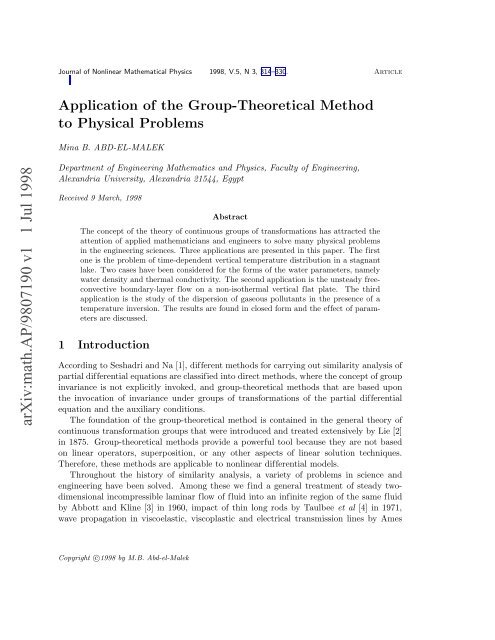
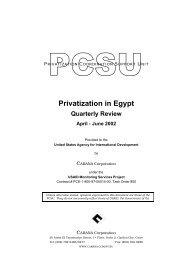
![Download entire catalog in pdf format [1.5MB] - The American ...](https://img.yumpu.com/51079239/1/190x260/download-entire-catalog-in-pdf-format-15mb-the-american-.jpg?quality=85)

